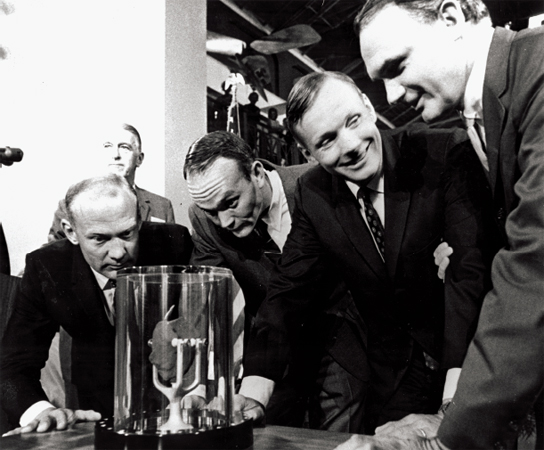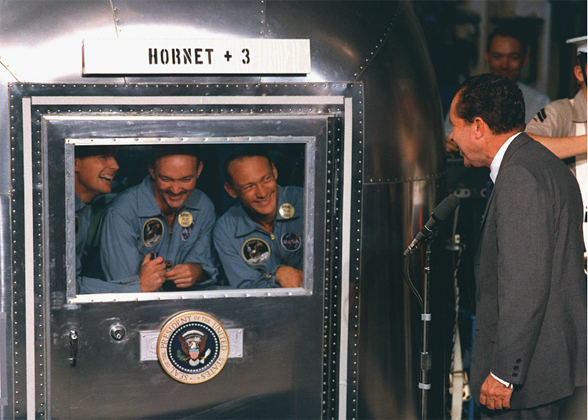
Buzz Aldrin completes the set up for the seismic experiment on the lunar surface. The sensitive equipment relayed data to Earth that allowed researchers to study the inner structure of the Moon.
One of the moonwalkers’ roles was to serve as the eyes of scientists back on Earth. Geologists, they knew, were eager to study samples taken from the Moon’s surface. To fill their orders, the astronauts collected 48 pounds (21.8 kilograms) of rocks and soil. They chose carefully, gathering specimens of varied sizes and colors. Aldrin, looking for the unusual, picked up some sparkly purple rocks.1
The moonwalkers set up an array of scientific gear. The seismic experiment measured lunar quakes and meteor strikes. The data was radioed to Earth and allowed researchers to study the inner structure of the Moon. The device began to pick up the tiny tremors caused by the astronaut’s footfalls almost at once. A second device, the laser reflector, bounced laser beams from Earth back to their source. Measuring the beam’s travel time allowed scientists to measure the Moon’s exact distance from Earth. The solar wind panel trapped atomic particles streaming from the sun. The particles, researchers hoped, would help them understand the nature of solar radiation.2

Buzz Aldrin completes the set up for the seismic experiment on the lunar surface. The sensitive equipment relayed data to Earth that allowed researchers to study the inner structure of the Moon.
The televised images streaming back to Earth showed two ghostly, space-suited figures. Helmets shielded the astronauts from the sun’s glare. Life-support backpacks supplied them with oxygen. Temperature-control systems insulated them from the deadly cold and broiling heat. Layer upon layer of tough fabric guarded against leaks. A moonwalker who ripped his suit on a sharp rock would be dead in seconds.
As the clock ticked, Mission Control carefully monitored the astronauts’ heart rates. Pleased by the readings, controllers added thirty minutes to the moonwalk. Finally, at the two-and-a-half hour mark, they gave the order to leave.3 Before closing the hatch, Armstrong and Aldrin tossed a small packet onto the ground near the lander. Inside the packet was a goodwill message, a gold olive branch, an Apollo 1 patch, and two medals. The patch and the medals honored the three astronauts and two cosmonauts who had given their lives to the quest to explore space.4

Buzz Aldrin (left), Michael Collins (center), and Neil Armstrong present Frank Taylor, president of the Smithsonian Institute, with a Moon rock. Geologists were anxious to study the soil and rock samples that Armstrong and Aldrin collected on the Moon.
Back in the lander, the astronauts prepared for the ascent. To save weight, they dumped their excess gear outside the lander. With the hatch sealed and their helmets off, they sniffed the sharp, ashy odor of moon dust for the first time. Aldrin thought it smelled like gunpowder.5 After Houston quizzed them about the moonwalk, the two men settled down to rest. Sleep did not come easily in the cramped, chilly cabin. Earthlight flooding through the windows made it even more difficult for Armstrong to sleep.
While the astronauts slept, instruments detected a sharp impact on the lunar surface. The Soviets, in an effort to steal Apollo 11’s glory, had tried to land an unmanned spacecraft. If Luna 15 had scooped up some soil and beaten Apollo back to Earth, the gamble might have paid off. Apollo 11’s luck was still good, however. Instead of a soft landing, the Soviet spacecraft crashed a few hundred miles away.6
Eagle’s next test was to make a proper ascent. The astronauts knew they had one chance to get it right. High overhead, orbiting in Columbia, Michael Collins knew it, too. If something went wrong, he would be forced to return to Earth alone. The thought filled him with dread.7
In the end, the ascent was trouble free. The engine fired on schedule, leaving the descent stage behind as it rocketed Eagle skyward. Once the ascent stage reached orbit, a series of short burns moved it in close to Columbia.
In the command module, Collins used his thrusters to close the gap. The two ships docked with hardly a bump. Moments later, as Collins put it, “All hell broke loose.”8 One of Eagle’s thrusters fired briefly, throwing the ships into a jerking spin. Reacting quickly, Collins used his own thrusters to regain control. The danger past, the moonwalkers took a moment to vacuum moon dust off their suits. Then they handed the sealed rock boxes through to Collins. “I handled them,” he said later, “as if they were . . . jam-packed with rare jewels.”9
Armstrong and Aldrin crawled back to their seats in Columbia. With the hatches closed, Collins cut Eagle loose to drift in Moon orbit. The three men relaxed for a while and then turned to the job of preparing for the return to Earth. Collins fired the three-minute “get-us-home burn” while Columbia was behind the Moon. Ten minutes later, the ship flew back into radio contact with Earth.
“How did it go? Over,” CapCom Charlie Duke asked from Houston. When Michael Collins confirmed that all was well, Duke relaxed. “Roger,” he said. “We got you coming home.”10
The long downhill “coast” to Earth took nearly three days. Thanks to Houston’s precise programming, only one small midcourse correction was needed. Collins left the controls long enough to prepare his favorite space lunch of cream of chicken soup.11 Along with some chores, the crew slept, listened to music, and caught up on news from home.
As the hours counted down, the astronauts cut loose the service module. With Columbia moving at thirty times the speed of sound, the reentry angle had to be perfect. If the angle were too steep, the capsule would burn up when it hit the atmosphere. If it were too shallow, the spacecraft would skip off into space. Once again, the numbers were right on target. The astronauts watched their heat shield glow a fiery orange-yellow as the ship plunged into the atmosphere. Lookouts on the USS Hornet saw what looked like a meteor streaking across the sky.

Soon after their successful splashdown, the Apollo 11 astronauts left Columbia and climbed into a life raft. A Navy diver joined them as they waited to be picked up by a helicopter from the USS Hornet.

Joan Aldrin (center), Buzz’s wife, leads the applause as family and friends celebrate Apollo II’s successful splashdown.
Drogue chutes popped out to steady the speeding capsule. Moments later, the three main parachutes opened with a comforting jerk. Slowed to 21 miles (34 kilometers) per hour, Columbia splashed into the Pacific Ocean—and promptly turned upside down. Working swiftly, the men inflated a set of air bags that turned the capsule right side up. By that time, a rescue team dispatched from the USS Hornet had reached them. Before they opened the hatch, the astronauts swallowed motion-sickness pills. This was no time to get seasick.
In the control room in Houston, a big message board lit up. First, the main panel spelled out President Kennedy’s 1961 pledge to land a man on the Moon and return him safely to Earth. Then a side panel lit up with this proud announcement:
TASK ACCOMPLISHED
JULY 196912
The Apollo crew returned to cheers and banner headlines, but not to hugs and handshakes. Some officials were worried that the astronauts might have carried alien germs back to Earth. The director of the lunar receiving lab said he did not expect to find any harmful life-forms. “But,” he added, “you can’t be too careful.”13 The moment the astronauts opened the hatch, a Navy diver handed them a set of isolation suits. After climbing into a life raft, they sprayed each other with disinfectant. The waiting sailors gave the capsule the same treatment.
Back at the Hornet, the space heroes were hustled into a mobile quarantine unit. Once inside, the astronauts peeled off their sweaty suits and took long showers. Refreshed and dressed in flying outfits, they looked out to see President Nixon waiting to welcome them.14 Three days later, the unit was flown back to Texas and trucked to an $8 million quarantine facility. A team of doctors and technicians showed the crew their quarters and started medical tests. Far underground, a second team broke open the first box of moon rocks.

Neil Armstrong (left), Michael Collins (center), and Buzz Aldrin look out the window of their mobile quarantine facility as they talk to President Richard Nixon. The three astronauts had to endure days of medical testing before the quarantine was lifted.
Eighteen days after splashdown, the lab gave each of the astronauts a clean bill of health. Neither the men nor the moon rocks were hosts to alien life-forms. The lab director broke the quarantine seal, and the space heroes stepped into the glare of television lights. It was the first step in a long victory lap.